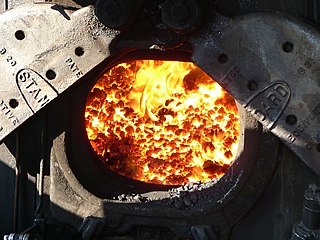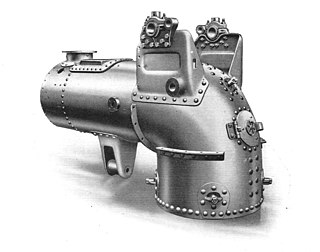 W
WA launch-type, gunboat or horizontal multitubular boiler is a form of small steam boiler. It consists of a cylindrical horizontal shell with a cylindrical furnace and fire-tubes within this.
 W
WA fire-tube boiler is a type of boiler in which hot gases pass from a fire through one or more tubes running through a sealed container of water. The heat of the gases is transferred through the walls of the tubes by thermal conduction, heating the water and ultimately creating steam.
 W
WA high pressure watertube boiler is a type of boiler in which water circulates in tubes heated externally by the fire. Fuel is burned inside the furnace, creating hot gas which boils water in the steam-generating tubes. In smaller boilers, additional generating tubes are separate in the furnace, while larger utility boilers rely on the water-filled tubes that make up the walls of the furnace to generate steam.
 W
WIn a steam engine, the firebox is the area where the fuel is burned, producing heat to boil the water in the boiler. Most are somewhat box-shaped, hence the name. The hot gases generated in the firebox are pulled through a rack of tubes running through the boiler.
 W
WThe Franco–Crosti boiler is a type of boiler used for steam locomotives. It was designed in the 1930s by Attilio Franco and Dr Piero Crosti. The main difference between it and conventional feedwater heaters widely used on the continent is that the Franco-Crosti boiler uses both exhaust steam and exhaust gases from the firebox. Conventional feedwater heaters only use exhaust steam.
 W
WA haycock boiler is an early form of steam locomotive boiler with a prominently raised firebox of "Gothic arch", "haystack", or "coppernob" shape. The term haystack is most commonly used, but is avoided here as it is confusingly used for three quite different forms of boiler. This particularly large outer firebox served as the steam dome and was often highly decorated with polished brass. These were popular for early railway locomotives, from 1840 to the 1850s.
 W
WIn a steam engine, the firebox is the area where the fuel is burned, producing heat to boil the water in the boiler. Most are somewhat box-shaped, hence the name. The hot gases generated in the firebox are pulled through a rack of tubes running through the boiler.
 W
WNorthumbrian was an early steam locomotive built by Robert Stephenson in 1830 and used at the opening of the Liverpool and Manchester Railway. It was the last of Stephenson's 0-2-2 locomotives in the style of Rocket, but it introduced several innovations. It was the first locomotive to have the Stephenson type firebox incorporated in the boiler, and having a smokebox the full diameter of the boiler, it therefore had the first true 'locomotive' boiler. It also had plate frames, a proper tender, and the cylinders set at a relatively low angle to the horizontal, giving smoother running. The pace of development of locomotive design at the time can be seen by comparing this engine with Stephenson's Planet, produced later the same year.
 W
WA pistol boiler is a design of steam boiler used in light steam tractors and overtype steam wagons. It is noted for the unusual shape of the firebox, a circular design intended to be self-supporting without the use of firebox stays.